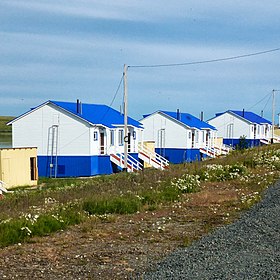Laborovaïa
| Laborovaïa | ||

| ||
| Administration | ||
|---|---|---|
| Pays | ||
| Géographie | ||
| Coordonnées | 67° 38′ 26″ nord, 67° 33′ 05″ est | |
| Localisation | ||
| Géolocalisation sur la carte : Russie
| ||
| modifier |
||
Laborovaïa (en russe : Лаборовая) est une hameau situé dans le district autonome de Iamalo-Nénétsie en Sibérie (oblast de Tioumen ; Russie). Située en territoire nénètse, la petite localité est entourée de campements destinés à l'élevage des rennes. Environ 20 familles résident à Laborovaïa.
Géographie et climat
[modifier | modifier le code]Le village de Laborovaïa se trouve en Iamalie (Sibérie). Appartenant au raïon de l'Oural, il est situé à environ 200 kilomètres au nord de la capitale de Iamalie, Salekhard[1].
Le climat dans la zone de Laborovaïa est de type subarctique[2]. L'écosystème environnant est une toundra[3].
Population
[modifier | modifier le code]Au début des années , une vingtaine de familles habitaient à Laborovaïa[1].
Le village est situé dans le territoire du peuple nénètse[3].
Renniculture
[modifier | modifier le code]Dans la zone autour du village, plusieurs campements nénètses sont destinés à la renniculture[1].
Notes et références
[modifier | modifier le code]Notes
[modifier | modifier le code]Références
[modifier | modifier le code]- Laptander (2013), p. 186.
- (en) « Laborovaya, Yamalo-Nenetskiy Avtonomnyy Okrug, Russia »
 , sur mindat.org (consulté le ).
, sur mindat.org (consulté le ).
- Golovnev et Osherenko (1999), p. 110.
Bibliographie
[modifier | modifier le code]- (en) Andreï V. Golovnev et Gail Osherenko, Siberian Survival : The Nenets and Their Story, Ithaca ; Londres, Cornell University Press, , 173 p. (ISBN 0-8014-3631-1, lire en ligne).

- (en) Roza I. Laptander, chap. 10 « Model for the Tundra School in Yamal : a New Education System for Children from Nomadic and Semi-nomadic Nenets Families », dans Erich Kasten et Tjeerd de Graaf, Sustaining Indigenous Knowledge : Learning Tools and Community Initiatives for Preserving Endangered Languages and Local Cultural Heritage, Fürstenberg / Havel, Kulturstiftung Sibirien, , 284 p. (ISBN 978-3-942883-122, lire en ligne), p. 181-194.

Text is available under the CC BY-SA 4.0 license; additional terms may apply.
Images, videos and audio are available under their respective licenses.

